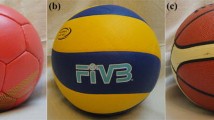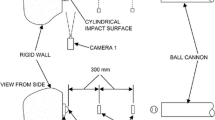Abstract
There are some features for an approved soccer ball by Fédération Internationale de Football Association (FIFA), such as properties of the material, mass, pressure, stitches, etc. Many of these features up to now have been studied; nevertheless, the mechanical properties of the soccer balls to date have not been well reported. The chief purposes of the current research, hence, were to calculate the mechanical properties of the soccer balls, i.e., linear elastic, nonlinear hyperelastic, and viscoelastic, at two different sizes, including 4 and 5 which are using for football and futsal, respectively. To do this, compressive and stress-relaxation loading were applied to 38 approved soccer balls to quantify the stress–strain as well as reduced relaxation function of the balls. The strain/displacement of the balls was also measured via a high-speed camera using Digital Image Correlation (DIC) technique. The results revealed the mean elastic modulus of 66 and 67 kPa for the football and futsal balls, respectively. In addition, the maximum stresses of the football and futsal balls were 16 and 13 kPa, respectively. The nonlinear mechanical response of the soccer balls were analyzed using hyperelastic material models, i.e., Mooney-Rivlin and Ogden. A Finite Element (FE) model was also developed to verify the hyperelastic data compared to the experimental ones and, remarkably, the numerical data were in consistence with the experimental data. Finally, Prony- series was employed to quantify the viscoelastic properties of the balls. During the game, a soccer ball can reach to a speed of 210 km/h that can damage the human eye; however, the injury detail still has not been studied.






Similar content being viewed by others
References
Stamm H, Lamprecht M (2001) FIFA Big Count. L&S Social Research und Consultation AG Zurich
Jordan SE, Green GA, Galanty HL, Mandelbaum BR, Jabour BA (1996) Acute and chronic brain injury in United States National Team soccer players. Am J Sports Med 24:205–210
Asai T, Seo K, Kobayashi O, Sakashita R (2007) Fundamental aerodynamics of the soccer ball. Sports Eng 10:101–109
Baroff GS (1998) Is heading a soccer ball injurious to brain function? J Head Trauma Rehabil 13:45–52
Collins MW, Grindel SH, Lovell MR, Dede DE, Moser DJ, Phalin BR et al (1999) Relationship between concussion and neuropsychological performance in college football players. JAMA 282:964–970
Green GA, Jordan SE (1998) Are brain injuries a significant problem in soccer? Clinics Sports Med 17:795–809
Kelly JP (1999) Traumatic brain injury and concussion in sports. JAMA 282:989–991
Matser J, Kessels A, Jordan B, Lezak M, Troost J (1998) Chronic traumatic brain injury in professional soccer players. Neurology 51:791–796
Tysvaer AT (1992) Head and neck injuries in soccer. Sports Med 14:200–213
Barrell G, Cooper P, Elkington A, Macfadyen J, Powell R, Tormey P (1981) Squash ball to eye ball: the likelihood of squash players incurring an eye injury. Br Med J 283:893
Nevins D, Smith L (2013) Influence of ball properties on simulated ball-to-head impacts. Procedia Eng 60:4–9
Crisco JJ, Drewniak EI, Alvarez MP, Spenciner DB (2005) Physical and mechanical properties of various field lacrosse balls. J Appl Biomech 21:383
Hendee SP, Greenwald RM, Crisco JJ (1998) Static and dynamic properties of various baseballs. J Appl Biomech 14:390–400
Ranga D, Strangwood M (2010) Finite element modelling of the quasi-static and dynamic behaviour of a solid sports ball based on component material properties. Procedia Eng 2:3287–3292
Alagheband M, Rahmani S, Alizadeh M, Karimi A, Navidbakhsh M (2015) Hemodynamic investigation of intraluminal thrombus effect on the wall stress in a stented three-layered aortic aneurysm model under pulsatile flow. Artery Res 10:11–19
Halabian M, Karimi A, Beigzadeh B, Navidbakhsh M (2015) A numerical study on the hemodynamic and shear stress of double aneurysm through s-shaped vessel. Biomed Eng Appl Basis Commun 27:1550033–1550043
Cordingley L (2002) Advanced modelling of hollow sports ball impacts: PhD Thesis, Loughborough University, Loughborough, UK
Karimi A, Navidbakhsh M, Haghi AM (2014) An experimental study on the structural and mechanical properties of polyvinyl alcohol sponge using different stress–strain definitions. Adv Polym Tech 33
Karimi A, Navidbakhsh M (2014) A comparative study on the uniaxial mechanical properties of the umbilical vein and umbilical artery using different stress–strain definitions. Australas Phys Eng Sci Med: 1–10
Karimi A, Navidbakhsh M (2014) Material properties in unconfined compression of gelatin hydrogel for skin tissue engineering applications. Biomed Tech (Berl) 59:479–486
Karimi A, Navidbakhsh M, Yousefi H (2014) Mechanical properties of polyvinyl alcohol sponge under different strain rates. Int J Mater Res 105:404–408
Karimi A, Navidbakhsh M (2014) Measurement of the nonlinear mechanical properties of a poly (vinyl alcohol) sponge under longitudinal and circumferential loading. J Appl Polym Sci 131
Karimi A, Kudo S, Razaghi R, Navidbakhsh M (2015) A combination of experimental and numerical analyses to measure the compressive mechanical properties of tennis ball. Biomed Eng Appl Basis Commun p 1550039
Jarrahi A, Karimi A, Navidbakhsh M, Ahmadi H (2015) Experimental/numerical study to assess mechanical properties of healthy and Marfan syndrome ascending thoracic aorta under axial and circumferential loading. Mater Tech Adv Perform Mater pp 1753555715Y–0000000049
Karimi A, Navidbakhsh M, Rezaee T, Hassani K (2015) Measurement of the circumferential mechanical properties of the umbilical vein: experimental and numerical analyses. Comput Methods Biomech Biomed Engin 18:1418–1426
Karimi A, Haghighatnama M, Shojaei A, Navidbakhsh M, Haghi AM, Sadati SJA (2015) Measurement of the viscoelastic mechanical properties of the skin tissue under uniaxial loading. J Mater Design Appl, Proc IMech Part L, p 1464420715575169
Karimi A, Rahmati SM, Navidbakhsh M (2015) Mechanical characterization of the rat and mice skin tissues using histostructural and uniaxial data. Bioengineered 6:153–160
Gloria A, Borzacchiello A, Causa F, Ambrosio L (2012) Rheological characterization of hyaluronic acid derivatives as injectable materials toward nucleus pulposus regeneration. J Biomater Appl 26:745–759
Hashin Z (1983) Analysis of composite materials—a survey. J Appl Mech 50:481–505
Karimi A, Navidbakhsh M, Alizadeh M, Razaghi R (2014) A comparative study on the elastic modulus of polyvinyl alcohol sponge using different stress-strain definitions. Biomed Tech (Berl) 59:439–446
Karimi A, Kudo S, Razaghi R, Navidbakhsh M (2015) Measurement of the mechanical properties of the handball, volleyball, and basketball using DIC method: a combination of experimental, constitutive, and viscoelastic models. Sport Sci Health. doi:10.1007/s11332-015-0240-2
Karimi A, Faturechi R, Navidbakhsh M, Hashemi SA (2014) A nonlinear hyperelastic behavior to identify the mechanical properties of rat skin under uniaxial loading. J Mech Med Biol 14
Karimi A, Navidbakhsh M (2014) An experimental study on the mechanical properties of rat brain tissue using different stress–strain definitions. J Mater Sci Mater Med 25:1623–1630
Karimi A, Navidbakhsh M, Razaghi R (2014) A finite element study of balloon expandable stent for plaque and arterial wall vulnerability assessment. J Appl Phys 116:044701
Karimi A, Navidbakhsh M, Razaghi R (2014) Plaque and arterial vulnerability investigation in a three-layer atherosclerotic human coronary artery using computational fluid-structure interaction method. J Appl Phys 116:064701
Karimi A, Navidbakhsh M, Alizadeh M, Shojaei A (2014) A comparative study on the mechanical properties of the umbilical vein and umbilical artery under uniaxial loading. Artery Res 8:51–56
Karimi A, Haghighatnama M, Navidbakhsh M, Haghi AM (2015) Measurement of the axial and circumferential mechanical properties of rat skin tissue at different anatomical locations. Biomed Tech (Berl). 60:115–122
Karimi A, Navidbakhsh M, Haghighatnama M, Haghi AM (2015) Determination of the axial and circumferential mechanical properties of the skin tissue using experimental testing and constitutive modeling. Comput Methods Biomech Biomed Eng 18:1768–1774
Karimi A, Navidbakhsh M (2015) Measurement of the uniaxial mechanical properties of rat skin using different stress–strain definitions. Skin Res Technol 21:149–157
Karimi A, Navidbakhsh M, Shojaei A (2015) A combination of histological analyses and uniaxial tensile tests to determine the material coefficients of the healthy and atherosclerotic human coronary arteries. Tissue Cell 47:152–158
Karimi A, Navidbakhsh M (2013) Mechanical properties of PVA material for tissue engineering applications. Mater Tech Adv Perform Mater 29:90–100
Troyer KL, Puttlitz CM (2011) Human cervical spine ligaments exhibit fully nonlinear viscoelastic behavior. Acta Biomater 7:700–709
Lucas SR, Bass CR, Salzar RS, Oyen ML, Planchak C, Ziemba A et al (2008) Viscoelastic properties of the cervical spinal ligaments under fast strain-rate deformations. Acta Biomater 4:117–125
Price D, Jones R, Harland A (2006) Soccer ball anisotropy modelling. Mater Sci Eng A 420:100–108
Price D, Jones R, Harland A (2006) Computational modelling of manually stitched soccer balls. Proc IMech Part L J Mater Design Appl 220:259–268
Author information
Authors and Affiliations
Corresponding author
Ethics declarations
Conflict of interest
We state that no conflict of interest exists for this work.
Ethical approval
This study has nothing to do with human samples, however, all the procedures in this study has been conducted according to the ethical standards.
Informed consent
For this type of research informed consent is not required.
Funding
This research received no specific grant from any funding agency in the public, commercial, or not-for-profit sectors.
Rights and permissions
About this article
Cite this article
Karimi, A., Razaghi, R., Navidbakhsh, M. et al. Measurement of the mechanical properties of soccer balls using digital image correlation method. Sport Sci Health 12, 69–76 (2016). https://doi.org/10.1007/s11332-015-0255-8
Received:
Accepted:
Published:
Issue Date:
DOI: https://doi.org/10.1007/s11332-015-0255-8




